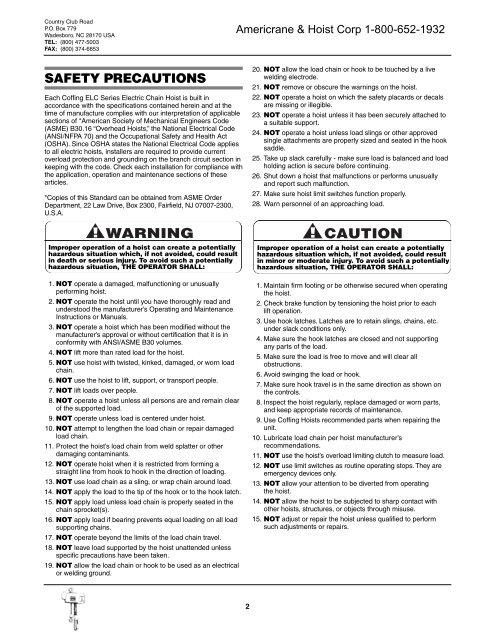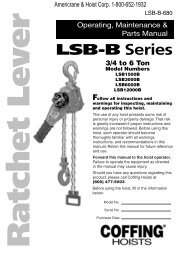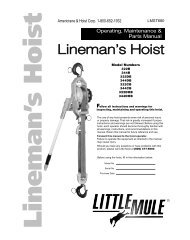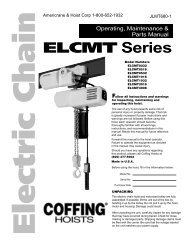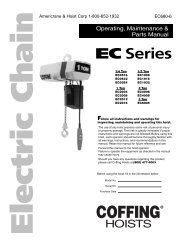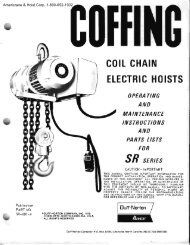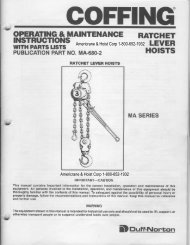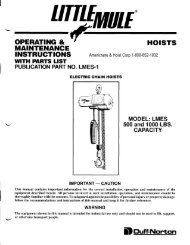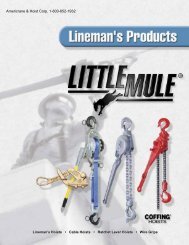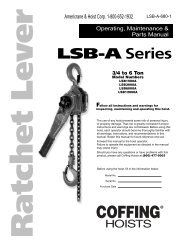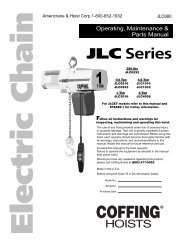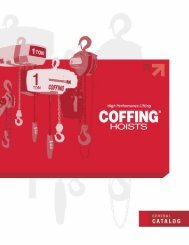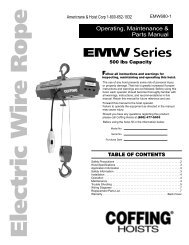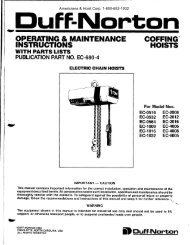ELC Series, JL 680-2 - Coffing Hoists, Coffing Hoist Parts
ELC Series, JL 680-2 - Coffing Hoists, Coffing Hoist Parts
ELC Series, JL 680-2 - Coffing Hoists, Coffing Hoist Parts
You also want an ePaper? Increase the reach of your titles
YUMPU automatically turns print PDFs into web optimized ePapers that Google loves.
Country Club Road<br />
P.O. Box 779<br />
Wadesboro, NC 28170 USA<br />
TEL: (800) 477-5003<br />
FAX: (800) 374-6853<br />
SAFETY PRECAUTIONS<br />
Each <strong>Coffing</strong> <strong>ELC</strong> <strong>Series</strong> Electric Chain <strong>Hoist</strong> is built in<br />
accordance with the specifications contained herein and at the<br />
time of manufacture complies with our interpretation of applicable<br />
sections of *American Society of Mechanical Engineers Code<br />
(ASME) B30.16 “Overhead <strong><strong>Hoist</strong>s</strong>,” the National Electrical Code<br />
(ANSI/NFPA 70) and the Occupational Safety and Health Act<br />
(OSHA). Since OSHA states the National Electrical Code applies<br />
to all electric hoists, installers are required to provide current<br />
overload protection and grounding on the branch circuit section in<br />
keeping with the code. Check each installation for compliance with<br />
the application, operation and maintenance sections of these<br />
articles.<br />
*Copies of this Standard can be obtained from ASME Order<br />
Department, 22 Law Drive, Box 2300, Fairfield, NJ 07007-2300,<br />
U.S.A.<br />
20. NOT allow the load chain or hook to be touched by a live<br />
welding electrode.<br />
21. NOT remove or obscure the warnings on the hoist.<br />
22. NOT operate a hoist on which the safety placards or decals<br />
are missing or illegible.<br />
23. NOT operate a hoist unless it has been securely attached to<br />
a suitable support.<br />
24. NOT operate a hoist unless load slings or other approved<br />
single attachments are properly sized and seated in the hook<br />
saddle.<br />
25. Take up slack carefully - make sure load is balanced and load<br />
holding action is secure before continuing.<br />
26. Shut down a hoist that malfunctions or performs unusually<br />
and report such malfunction.<br />
27. Make sure hoist limit switches function properly.<br />
28. Warn personnel of an approaching load.<br />
Improper operation of a hoist can create a potentially<br />
hazardous situation which, if not avoided, could result<br />
in death or serious injury. To avoid such a potentially<br />
hazardous situation, THE OPERATOR SHALL:<br />
1. NOT operate a damaged, malfunctioning or unusually<br />
performing hoist.<br />
2. NOT operate the hoist until you have thoroughly read and<br />
understood the manufacturer’s Operating and Maintenance<br />
Instructions or Manuals.<br />
3. NOT operate a hoist which has been modified without the<br />
manufacturer’s approval or without certification that it is in<br />
conformity with ANSI/ASME B30 volumes.<br />
4. NOT lift more than rated load for the hoist.<br />
5. NOT use hoist with twisted, kinked, damaged, or worn load<br />
chain.<br />
6. NOT use the hoist to lift, support, or transport people.<br />
7. NOT lift loads over people.<br />
8. NOT operate a hoist unless all persons are and remain clear<br />
of the supported load.<br />
9. NOT operate unless load is centered under hoist.<br />
10. NOT attempt to lengthen the load chain or repair damaged<br />
load chain.<br />
11. Protect the hoist’s load chain from weld splatter or other<br />
damaging contaminants.<br />
12. NOT operate hoist when it is restricted from forming a<br />
straight line from hook to hook in the direction of loading.<br />
13. NOT use load chain as a sling, or wrap chain around load.<br />
14. NOT apply the load to the tip of the hook or to the hook latch.<br />
15. NOT apply load unless load chain is properly seated in the<br />
chain sprocket(s).<br />
16. NOT apply load if bearing prevents equal loading on all load<br />
supporting chains.<br />
17. NOT operate beyond the limits of the load chain travel.<br />
18. NOT leave load supported by the hoist unattended unless<br />
specific precautions have been taken.<br />
19. NOT allow the load chain or hook to be used as an electrical<br />
or welding ground.<br />
Improper operation of a hoist can create a potentially<br />
hazardous situation which, if not avoided, could result<br />
in minor or moderate injury. To avoid such a potentially<br />
hazardous situation, THE OPERATOR SHALL:<br />
1. Maintain firm footing or be otherwise secured when operating<br />
the hoist.<br />
2. Check brake function by tensioning the hoist prior to each<br />
lift operation.<br />
3. Use hook latches. Latches are to retain slings, chains, etc.<br />
under slack conditions only.<br />
4. Make sure the hook latches are closed and not supporting<br />
any parts of the load.<br />
5. Make sure the load is free to move and will clear all<br />
obstructions.<br />
6. Avoid swinging the load or hook.<br />
7. Make sure hook travel is in the same direction as shown on<br />
the controls.<br />
8. Inspect the hoist regularly, replace damaged or worn parts,<br />
and keep appropriate records of maintenance.<br />
9. Use <strong>Coffing</strong> <strong><strong>Hoist</strong>s</strong> recommended parts when repairing the<br />
unit.<br />
10. Lubricate load chain per hoist manufacturer’s<br />
recommendations.<br />
11. NOT use the hoist’s overload limiting clutch to measure load.<br />
12. NOT use limit switches as routine operating stops. They are<br />
emergency devices only.<br />
13. NOT allow your attention to be diverted from operating<br />
the hoist.<br />
14. NOT allow the hoist to be subjected to sharp contact with<br />
other hoists, structures, or objects through misuse.<br />
15. NOT adjust or repair the hoist unless qualified to perform<br />
such adjustments or repairs.<br />
2


